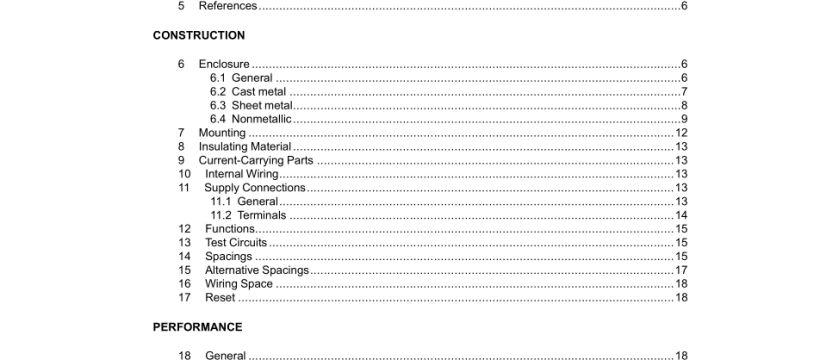UL 1053-2020 pdf download.Ground-Fault Sensing and Relaying Equipment.
3 Components 3.1 Except as indicated in 3.2, a component of a product covered by this Standard shall comply with the requirements for that component. See Appendix A for a list of standards covering components generally used in the products covered by this Standard. 3.2 A component is not required to comply with a specific requirement that: a) Involves a feature or characteristic not required in the application of the component in the product covered by this standard, or b) Is superseded by a requirement in this standard. 3.3 A component shall be used in accordance with its rating established for the intended conditions of use. 3.4 Specific components are incomplete in construction features or restricted in performance capabilities. Such components are intended for use only under limited conditions, such as certain temperatures not exceeding specified limits, and shall be used only under those specific conditions. 4 Units of Measurement 4.1 Values stated without parentheses are the requirement. Values in parentheses are explanatory or approximate information. 5 References 5.1 Any undated reference to a code or standard appearing in the requirements of this standard shall be interpreted as referring to the latest edition of that code or standard.
6.1.3 Among the factors taken into consideration when an enclosure is being judged for acceptability are its physical strength, resistance to impact, moisture-absorptive properties, combustibility, resistance to corrosion, and resistance to distortion at temperatures to which the enclosure may be subject under conditions of normal or abnormal use. For a nonmetallic enclosure or part of an enclosure, all these factors are considered with respect to thermal aging. 6.1.4 There shall be no ventilating openings in the enclosure of ground-fault sensing and relaying equipment unless the conditions of use of such equipment necessitates ventilation and it can be shown by test that electrical disturbances within the enclosure will be contained. In no case shall there be such openings in an enclosure or a compartment of an enclosure containing a fuse or any portion of a circuit breaker other than the operating handle. 6.1.5 A ventilating opening in an enclosure, including a perforated hole, a louver, or an opening protected by means of wire screening, expanded metal, or a perforated cover, shall be of such size or shape that no opening will permit passage of a rod having a diameter greater than 1/2 inch (12.7 mm). Exception: Ifthe distance between an uninsulated live part and the opening is greater than 4 inches (102 mm), the opening may be larger than that previously mentioned, provided no opening will permit passage ofa rod having a diametergreaterthan 3/4 inch (19.1 mm). 6.1.6 The diameter of the wires of a screen shall not be less than 0.051 inch (1.30 mm) if the screen openings are 1/2 square inch (323 mm 2 ) or less in area, and shall not be less than 0.081 inch (2.06 mm) for larger screen openings.
6.2.2 Zinc-base die-cast metal shall not be used for an enclosure. 6.2.3 If threads for the connection of conduit are tapped all the way through a hole in an enclosure, or if an equivalent construction is employed, there shall not be less than three threads in the metal, and the construction of the device shall be such that a conduit bushing can be properly attached. 6.2.4 If the threads for the connection of conduit are not tapped all the way through a hole in an enclosure wall or the like, there shall not be less than five full threads in the metal and there shall be a smooth well-rounded inlet hole for the conductors. 6.2.5 The inlet hole shall: a) Afford protection to the conductors equivalent to that provided by a standard conduit bushing and b) Have an internal diameter approximately the same as that of the corresponding trade size of rigid conduit. 6.3 Sheet metal 6.3.1 A knockout in a sheet-metal enclosure shall be reliably secured but shall be capable of being removed without undue deformation of the enclosure. 6.3.2 A knockout shall be provided with a flat surrounding surface adequate for proper seating of a conduit bushing, and shall be so located that installation of a bushing at any knockout likely to be used during installation will not result in spacings between uninsulated live parts and the bushing of less than the minimum requirements in Table 14.1 . UL 1053-2020 pdf download.
UL 1053-2020 pdf download
